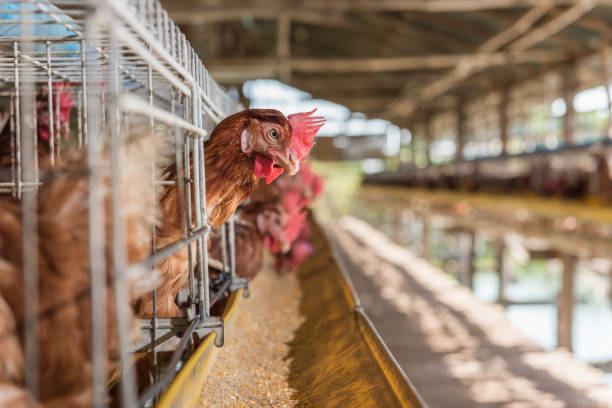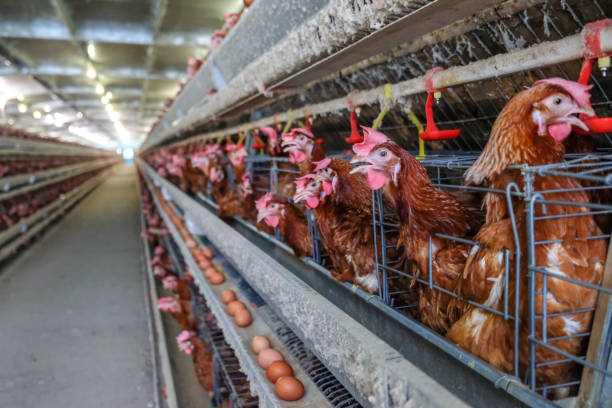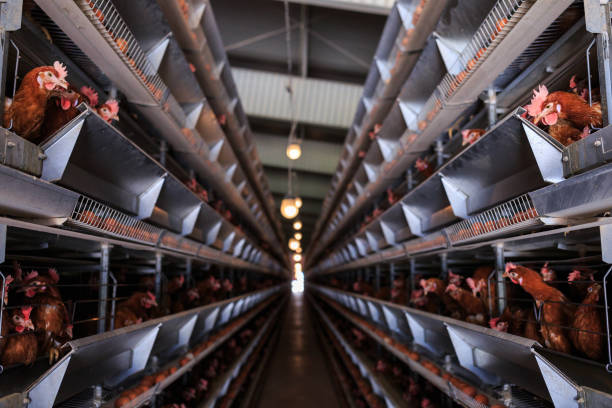
Affordable Poultry Cage Systems for Sale: Maximize Your Profits
Affordable Poultry Cage Systems for Sale: Maximize Your Profits
In the dynamic world of poultry farming, efficiency and profitability are the cornerstones of success. Whether you’re a seasoned poultry farmer or just starting, optimizing your operations can significantly impact your bottom line. One of the most effective ways to achieve this is by investing in affordable, high-quality poultry cage systems. This comprehensive guide explores the benefits of poultry cage systems, different types available, factors to consider when purchasing, and how to maximize your profits with the right cage system.

**Why Invest in Poultry Cage Systems?**
Poultry cage systems offer a multitude of advantages over traditional free-range or floor-based farming methods. These advantages contribute to better bird health, improved productivity, and increased profitability.
* **Improved Hygiene and Disease Control:** Caged environments provide a cleaner living space for your birds. Waste is collected and removed efficiently, reducing the risk of disease outbreaks and minimizing the need for antibiotics. This directly translates to healthier birds and lower veterinary costs.
* **Increased Egg Production:** Cage systems optimize laying conditions, leading to higher egg production rates. Birds are less stressed, have consistent access to food and water, and are protected from predators and harsh weather conditions.
* **Reduced Feed Wastage:** Cage designs minimize feed spillage, ensuring that birds consume most of the feed provided. This reduces feed costs, which can be a significant expense in poultry farming.
* **Better Space Utilization:** Cage systems allow you to house more birds in the same amount of space compared to free-range or floor systems. This optimizes land usage and increases the overall efficiency of your farm.
* **Easier Management and Monitoring:** Cage systems make it easier to manage and monitor your flock. You can easily observe individual birds, identify health issues, and provide targeted treatment. Egg collection is also simplified and more efficient.
**Types of Poultry Cage Systems**

Several types of poultry cage systems are available, each designed to meet specific needs and preferences. Understanding the different types will help you choose the system that best suits your farm.
* **Layer Cages:** These are designed for egg-laying hens. They typically feature individual or group compartments with feed troughs, water lines, and sloped floors for easy egg collection. Layer cages come in various configurations, including A-frame, H-frame, and flat-deck designs.
* **A-Frame Layer Cages:** This is a popular choice, particularly for smaller farms. The A-frame design is simple and cost-effective, providing good ventilation and easy access to birds.
* **H-Frame Layer Cages:** Ideal for larger-scale operations, H-frame cages maximize space utilization with multiple tiers of cages stacked vertically. They often incorporate automated feeding and egg collection systems.
* **Flat-Deck Layer Cages:** Flat-deck cages are suitable for farms with limited vertical space. They offer good visibility and accessibility for management and monitoring.
* **Broiler Cages:** These are designed for meat-producing chickens. Broiler cages provide a controlled environment that promotes rapid growth and efficient feed conversion.
* **Multi-Tier Broiler Cages:** These cages are designed to maximize space efficiency by stacking multiple tiers of cages on top of each other. This allows for a higher density of birds in a smaller footprint, making it ideal for large-scale operations.
* **Single-Tier Broiler Cages:** These cages consist of a single layer, making it easier to access and manage the birds. They are suitable for smaller farms or operations that prioritize ease of management over maximizing space efficiency.
* **Pullet Cages:** These are designed for raising young chickens (pullets) before they start laying eggs. Pullet cages provide a safe and controlled environment for optimal growth and development.
* **Breeder Cages:** These are specifically designed for breeding chickens. They provide separate compartments for hens and roosters, ensuring controlled mating and egg production.
**Factors to Consider When Purchasing Poultry Cage Systems**
Choosing the right poultry cage system requires careful consideration of several factors. Evaluating these factors will ensure that you invest in a system that meets your specific needs and maximizes your profitability.
* **Farm Size and Capacity:** The size of your farm and the number of birds you plan to raise will significantly influence the type and size of cage system you need. Consider the available space and choose a system that optimizes space utilization without overcrowding the birds.
* **Budget:** Poultry cage systems vary in price depending on the type, size, and features. Establish a budget and look for systems that offer the best value for your money. Remember to factor in the long-term benefits, such as increased egg production and reduced feed costs.
* **Climate and Environmental Conditions:** Consider the climate in your region and choose a cage system that can withstand the weather conditions. Look for features like ventilation systems, insulation, and climate control options to ensure the comfort and well-being of your birds.
* **Material and Durability:** The quality of materials used in the cage system will determine its durability and lifespan. Choose systems made from high-quality, corrosion-resistant materials that can withstand the rigors of daily use. Galvanized steel is a popular choice for its strength and resistance to rust.
* **Automation and Technology:** Automation can significantly improve efficiency and reduce labor costs. Consider cage systems with automated feeding, watering, egg collection, and waste removal systems.
* **Ease of Installation and Maintenance:** Choose a cage system that is easy to install and maintain. Look for systems with simple designs and readily available spare parts. Regular maintenance is essential to ensure the longevity and optimal performance of your cage system.
* **Bird Welfare:** While maximizing efficiency is important, it’s also crucial to prioritize the welfare of your birds. Choose a cage system that provides adequate space, ventilation, and access to food and water. Look for features that minimize stress and promote natural behaviors.
**Tips for Maximizing Profits with Poultry Cage Systems**
Investing in a poultry cage system is just the first step. To maximize your profits, you need to implement effective management practices and optimize your operations in several key areas.
* **Optimize Feeding and Nutrition:** Provide your birds with a balanced diet that meets their nutritional needs. Work with a poultry nutritionist to develop a feeding program that maximizes egg production or meat growth. Ensure that feed and water are always readily available.
* **Maintain Optimal Environmental Conditions:** Maintain a comfortable and consistent environment for your birds. Control temperature, humidity, and ventilation to minimize stress and promote optimal performance. Consider investing in climate control systems to regulate the environment year-round.
* **Implement a Strict Biosecurity Program:** Prevent disease outbreaks by implementing a strict biosecurity program. Control access to your farm, disinfect equipment and facilities, and monitor your birds regularly for signs of illness.
* **Monitor Egg Production and Growth Rates:** Track egg production and growth rates to identify any potential problems early on. Use data analysis to optimize your management practices and improve efficiency.
* **Reduce Mortality Rates:** Minimize mortality rates by providing proper care and attention to your birds. Identify and address any health issues promptly. Implement preventive measures to protect against common poultry diseases.
* **Efficient Waste Management:** Implement an efficient waste management system to minimize odors and prevent environmental pollution. Consider using manure as fertilizer or converting it into biogas for energy production.
* **Regular Maintenance and Repairs:** Perform regular maintenance on your cage system to ensure its longevity and optimal performance. Repair any damage promptly to prevent further deterioration.
* **Market Your Products Effectively:** Develop a strong marketing strategy to sell your eggs or meat at a competitive price. Focus on product quality and customer service to build a loyal customer base. Explore opportunities to sell directly to consumers or local businesses.
**Finding Affordable Poultry Cage Systems**
Finding affordable poultry cage systems requires research and comparison shopping. Here are some strategies to help you find the best deals:
* **Research Different Suppliers:** Contact multiple poultry equipment suppliers and compare their prices, products, and services. Look for suppliers with a good reputation and a track record of providing high-quality products.

* **Consider Used Equipment:** If you’re on a tight budget, consider purchasing used poultry cage systems. Used equipment can be a cost-effective option, but be sure to inspect it thoroughly before buying it.
* **Look for Sales and Discounts:** Many suppliers offer sales and discounts on poultry cage systems, particularly during certain times of the year. Keep an eye out for these promotions to save money.
* **Negotiate Prices:** Don’t be afraid to negotiate prices with suppliers. Many suppliers are willing to offer discounts, especially if you’re buying in bulk.
* **Consider Financing Options:** If you need help financing your purchase, explore different financing options, such as loans or leases.
**Conclusion**
Investing in affordable poultry cage systems can significantly improve the efficiency and profitability of your poultry farm. By choosing the right cage system for your needs and implementing effective management practices, you can maximize egg production, reduce feed costs, and improve bird health. Remember to prioritize bird welfare and choose systems that provide a comfortable and safe environment for your flock. With careful planning and execution, you can transform your poultry farm into a thriving and profitable business.
